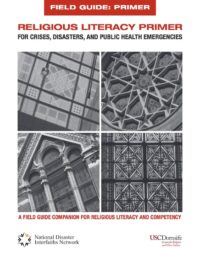A companion to the Field Guide for Religious Competency, the Religious Literacy Primer is a quick-reference document which provides information on basic religious literacy for 23 of the largest religious communities in the United States. Published by the USC Center for Religion and Civic Culture and the National Disaster Interfaiths Network, the two tools serve as accessible guides to help government agencies and non-profit organizations enhance their religious literacy and engage with faith communities during unsettled times.
The Religious Literacy Primer is geared toward enabling emergency managers, public health officials, first responders, volunteers, voluntary agencies and anyone involved in disaster response and recovery to understand how faith communities and emergency management intersect. It guides practitioners in their interaction with disaster-affected communities by moving beyond simplistic summaries of faith community beliefs and practices to provide guidance for physical interaction/etiquette, drawings of religious symbols, information on holidays, dietary restrictions and provision of post-disaster mass care including shelter, medical treatment and mental health care.
Both documents trace their origins to three turning points in recent U.S. history: the 1992 civil unrest in Los Angeles, the terrorist attacks of 2001 and Hurricane Katrina in 2005. Faith-based responders and civil authorities all rose to meet these challenges, but in each instance the need for greater coordination and collaboration among a wide array of responders became apparent.
Accordingly, the publication of the Field Guide and the Religious Literacy Primer is the result of an unprecedented collaboration among faith partners—Catholic, Protestant, Jewish, Muslim and Buddhist groups were represented at an event to launch these resources—as well as emergency management personnel from local, state and national levels.
“Faith groups have been instrumental in responding in times of crisis,” said Rev. David L. Myers, director of the Center for Faith-based and Neighborhood Partnerships in the Department of Homeland Security. “But in the past they weren’t networked with other faith-based groups or civil emergency managers. The publications from CRCC and NDIN reflect a new ‘whole community doctrine’ in disaster preparedness and response.”
Thus, in addition to providing essential information to governmental first-responders, the Field Guide and Religious Literacy Primer are also invaluable tools for congregations that want to integrate themselves into the growing network of faith-based and civil first responders.
“Nothing like this gets taught in seminary,” said Peter B. Gudaitis, M.Div., president of the National Disaster Interfaiths Network. “You have to learn it later on your own.” Helping other faith leaders to acquire the know-how to be effective responders–and to integrate their efforts with the work of government agencies–has become a life’s work for Gudaitis, who has over 25 years of experience in chaplaincy, disaster emergency management, faith-based philanthropy, program management and social services administration.
Natural and human-caused disasters are inevitable, but preparedness and coordination among responders can reduce suffering and speed recovery in the aftermath of a crisis. April Naturale, Senior Advisor to the SAMHSA Disaster Technical Assistance Center, said, “As we come to rely more and more on faith congregations before, during and after these events, we should heed the recommendations in the guide so that we get it right and learn how work side by side with faith communities from beginning to end.”
Since the mid 1990s, when responsibility for community resilience began to devolve from the federal government to state and local authorities as well as non-governmental organizations, faith-based groups have increasingly been called on to fulfill the promise of compassionate social engagement that lies at the heart of every spiritual tradition.
“Our aim with this project is, on the one hand, to help civil first-responders acquire the level of religious literacy and competency that they will need to partner with faith-based groups,” said Brie Loskota, CRCC’s managing director. “On the other hand, we want to help faith groups deliver on that vital promise.”
Download the Primer:
Lo Res PDF
Hi Res PDF
